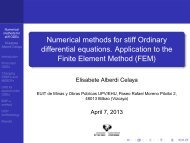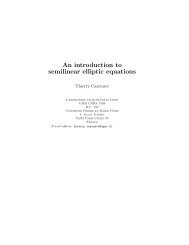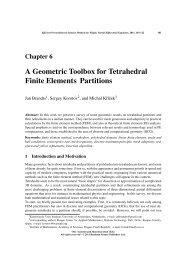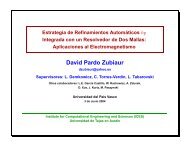An Introduction to Viscosity Solutions: theory, numerics and ... - BCAM
An Introduction to Viscosity Solutions: theory, numerics and ... - BCAM
An Introduction to Viscosity Solutions: theory, numerics and ... - BCAM
You also want an ePaper? Increase the reach of your titles
YUMPU automatically turns print PDFs into web optimized ePapers that Google loves.
<strong>An</strong> <strong>Introduction</strong> <strong>to</strong> <strong>Viscosity</strong> <strong>Solutions</strong>:<strong>theory</strong>, <strong>numerics</strong> <strong>and</strong> applicationsM. FalconeDipartimen<strong>to</strong> di MatematicaOPTPDE-<strong>BCAM</strong> Summer School”Challenges in Applied Control <strong>and</strong> Optimal Design”July 4-8, 2011, Bilbao – Lecture 1/4
OUTLINE OF THE COURSE:• Lecture 1: <strong>Introduction</strong> <strong>to</strong> viscosity solutions• Lecture 2: Approximation schemes for viscosity solutions• Lecture 3: Approximation of optimal control problems via DP• Lecture 4: Efficient methods <strong>and</strong> perspectives
OUTLINE OF THIS LECTURE:<strong>Introduction</strong> <strong>to</strong> viscosity solutions• Motivations (related <strong>to</strong> control problems)• <strong>Viscosity</strong> solutions for 1st order PDEs• Uniqueness for viscosity solutions• Some properties of viscosity solutions• Hopf–Lax representation formula• Some hints on viscosity solutions for 2nd order PDEs• Existence <strong>and</strong> uniqueness
MotivationsOur approach <strong>to</strong> the solution of optimal control problems <strong>and</strong>games is based on Dynamic Programming, another approach isbased on Pontryagin Maximum Principle.By the Dynamic Programming Principle, we will derive the characterizationof the value function in terms of a first order partialdifferential equation (PDE), the Bellman equation (or the Isaacsequation for games ).
MotivationsThis approach is interesting for the continuous control problemsas well for numerical purposes <strong>and</strong> can be applied <strong>to</strong> all classicalcontrol problems.In one of the following lectures we will deal with the constructionof approximation schemes via Discrete Dynamic Programming.We will also deal with the algorithms which allow <strong>to</strong> computethe value function, optimal controls in feedback form <strong>and</strong> thecorresponding optimal trajec<strong>to</strong>ries.
The finite horizon problemDynamics⎧⎨⎩ẏ(t) = b(y(t), α(t))y(t 0 ) = x 0where α(·) ∈ A ≡ {α : [0,+∞[→ A, measurable} <strong>and</strong> A ⊂ R M iscompactCostJ (t0 ,x 0 ) (α) ≡ ∫ tft 0f(y(s), α(s))e −λs ds + ψ(y(t f )), λ > 0Value function v(t 0 , x 0 ) ≡ infα∈A J (t 0 ,x 0 ) (α) .
The infinite horizon problemDynamics⎧⎨⎩ẏ(t) = b(y(t), α(t))y(0) = xwhere α(·) ∈ A ≡ {α : [0,+∞[→ A, measurable} <strong>and</strong> A ⊂ R M iscompactCostJ x (α) ≡∫ ∞0 f(y(s), α(s))e−λs ds , λ > 0Value function v(x) ≡ infα∈A J x(α) .
The infinite horizon problem with state constraintsDynamics⎧⎨⎩ẏ(t) = b(y(t), α(t))y(0) = xwhere y ∈ R N . Now we require that y x (t) ∈ Ω ⊂ R N for any t.Admissible controlsα(·) ∈ A x ≡ {α : [0,+∞[→ A, measurable such that y x (t) ∈ Ω}where A ⊂ R M is compact.
CostJ x (α) ≡∫ ∞0 f(y(s), α(s))e−λs ds , λ > 0Value function v(x) ≡infα∈A xJ x (α) .
The nonlinear minimum time problemDynamics⎧⎨⎩ẏ(t) = b(y(t), α(t))y(0) = xy ∈ R N<strong>and</strong> α(·) ∈ AwhereA ≡ {α(·) : [0,+∞[→ A measurable} <strong>and</strong> A ⊂ R M is compactTarget T is a compact set with nonempty interior
The minimum time function is:T(x) ≡inf {t : y x(t, α(t)) ∈ T }α(·)∈AA priori T is not defined everywhere, its domain of definition isthe reachable set ,R ≡ { x ∈ R N : T(x) < +∞ }Note that R is NOT given <strong>and</strong> can have a rather complicatedshape even for simple dynamics. This is a free-boundary problemwhere we have <strong>to</strong> detect the couple (T, R).
Value function <strong>and</strong> HJB equationThe link is the followingThe value function is the unique viscosity solution of the Bellmanequation associated <strong>to</strong> the problem via Dynamic Programming.For the infinite horizon problem this isλv(x) + max{−b(x, a) · ∇u(x) − f(x, a)} = 0, xa∈A∈ RN
Value function for a minimum time problem32.521.510.52010−1−2−2 −1.5 −1 −0.5 0 0.5 1 1.5 2
Value function for a state constraint problem
<strong>Viscosity</strong> solutions for 1st order PDEsLet us start with the stationary model problem⎧⎨⎩H(x, u, Du) = 0u(x) = g(x)in Ωon ∂Ω(HJ)where H : R n × R × R n → R is the Hamil<strong>to</strong>nian <strong>and</strong> g is a givenboundary condition.We want <strong>to</strong> define a good notion of weak solution since theproblem is nonlinear <strong>and</strong> we cannot expect a classical solution<strong>to</strong> (HJ).
Stationary 1st order PDEsThe previous examples have shown that we can have:• jumps in the gradient of the solution• jumps in the solution for the constrained problem <strong>and</strong>for differential gamesThe typical assumptions on the Hamil<strong>to</strong>nian H(x, u, p) <strong>to</strong> set upthe <strong>theory</strong> areA1: H(·, ·, ·) is uniformly continuousA2: H(x, u, ·) is convexA3: H(x, ·, p) is mono<strong>to</strong>ne
Example: |u x | = 1Consider the following Dirichlet problem for the eikonal equationin 1 dimension⎧⎨⎩|u x | = 1 in Ω ≡ (−1,1)u(x) = 0on ∂Ω(E)Obviously, u 1 (x) = x <strong>and</strong> u 2 (x) = −x satisfy the equation pointwisein (-1,1) but they do not satisfy the boundary conditions.Moreover, a classical solution can not exist due <strong>to</strong> Rolle Theorem.Both functions u 3 (x) = |x| − 1 <strong>and</strong> u 4 (x) = 1 − |x| satisfy theequation a.e. <strong>and</strong> satisfy the boundary conditions.
Example: |u x | = 1One can easily seen that there are infinitely many a.e. solutionsof the equation.In fact, collecting piecewise affine functions parallel <strong>to</strong> x or −xone can built a new a.e. solution.
Vanishing viscosity limitConsider the second order problem−εu xx + |u x | = 1, in (−1,1) (1)with the homogeneous boundary condition u(−1) = u(1). Thishas a regular solution u ε ∈ C 2 (−1,1) for every positive εWe can pass <strong>to</strong> the limit at every x ∈ Ω gettinglimε→0 uε (x) = u(x) (2)<strong>and</strong> define the limiting function u <strong>to</strong> be the weak solution of ourproblem (Kruzkov, 60s).Note that this is the reason for the name.
Definition of viscosity solutionsLet us consider the ”classical definition” for u ∈ BUC(Ω) (thespace of Bounded Uniformly Continuous function over the openset Ω).Note that the definition is direct (without any reference <strong>to</strong> aregularization <strong>and</strong>/or a limit) <strong>and</strong> LOCAL .
Definition of viscosity solutionsDEFINITIONu ∈ BUC(Ω) is a viscosity solution ofH(x, u, Du) = 0 in Ωif <strong>and</strong> only if, for any ϕ ∈ C 1 (Ω) the following conditions hold:i) at every local maximum point x o ∈ Ω for u − ϕH(x 0 , u(x 0 ), Dϕ(x 0 )) ≤ 0i.e. u is a viscosity sub-solution.ii) at every local minimum point x o ∈ Ω for u − ϕH(x 0 , u(x 0 ), Dϕ(x 0 )) ≥ 0i.e. u is a viscosity super-solution.
Example: |u x | = 1Let us go back <strong>to</strong> the example.Take any a.e solution u which has a local minimum at x 0 <strong>and</strong>choose (for example) ϕ = costant. Clearly, x 0 is a local minimumpoint for u − ϕ so that we should havewhich is FALSE since ϕ x ≡ 0.|ϕ x (x 0 ) ≥ 1Conclusion: every a.e. solution having a local minimum pointcannot be a viscosity super-solution.
Example: |u x | = 1The same argument will not work for sub-solutions.Take any a.e solution u which has a local maximum at x 0 <strong>and</strong>choose (for example) ϕ = costant. Clearly, x 0 is a local maximumpoint for u − ϕ so that we should have|ϕ x (x 0 )| ≤ 1which is TRUE since ϕ x ≡ 0.The only viscosity solution of our problem is v(x) = 1 − |x|.
Some properties of viscosity solutions1. If u is a classical C 1 (Ω) solution then it is also a viscositysolution.2. If u is a regular viscosity solution then it is also a classicalsolution (i.e. satisfies the equation pointwise).3. the viscosity solution u is the maximal sub-solution , i.e.w ≤ u, for any w ∈ S ≡ {space of sub-solutions}
4. (stability) the viscosity solution u is the uniform limit of u εwherewhich means−εu ε xx + H(x, u ε , Du ε ) = 0u(x) = limε→0 + uε (x)WARNING: as we have seen in the example, if u is a viscositysolution this DOES NOT IMPLY that −u is a viscosity solution(unless u is regular).
Comparison pricipleThe crucial point for viscosity solution is <strong>to</strong> prove uniqueness.This is done via a comparison principle (also called maximumprinciple).THEOREMLet u, v ∈ BUC(Ω) be respectively a sub <strong>and</strong> a super-solutionfor<strong>and</strong> letH(x, u, Du) = 0in ΩThen,u(x) ≤ v(x)for any x ∈ ∂Ω.u(x) ≤ v(x) for any x ∈ Ω.
Uniquess via the comparison principleThe comparison principle is enough <strong>to</strong> get uniqueness.In fact, let u <strong>and</strong> v be two viscosity solutions of the equationsatisfying the same boundary condition, clearly they are (both)sub <strong>and</strong> super-solutions. Then, we haveu(x) ≤ v(x) for any x ∈ ΩAND, reverting the role of u <strong>and</strong> v, alsou(x) ≥ v(x) for any x ∈ Ωwhich implies u(x) = v(x) in Ω.
Sufficient conditions for uniquenessLet ϕ : R → R + be continuous <strong>and</strong> ω(·) be a modulus of continuity.Let us assume thatA4 : |H(x, u, p) − H(y, u, p)| ≤ ω(|x − y|(1 + |p|))Q R (x, y, u, p)for any x, y ∈ Ω, −R ≤ u ≤ R <strong>and</strong> p ∈ R n , whereQ R (x, y, u, p) ≡ max(ϕ(H(x, u, p)) , ϕ(H(y, u, p))THEOREMLet the assumptions (A1–A4) be satisfied, then the comparisonprinciple holds for (HJ), i.e. the viscosity solution is unique.
Variable doublingThe goal is <strong>to</strong> prove that M = max(u − v) is negative.x∈ΩWe introduce a test function depending on two variables|x − y|2ψ ε (x, y) ≡ u(x) − v(y) −ε 2 .Due <strong>to</strong> the penalization term, we can expect that the maximumpoints (x ε , y ε ) for ψ ε should have x ε <strong>and</strong> y ε close enough for εsmall. Moreover, for ε → 0 + we have:M ε → M,|x ε − y ε | 2ε 2→ 0 <strong>and</strong> u(x ε ) − v(y ε ) → MThose properties allow <strong>to</strong> pass <strong>to</strong> the limit <strong>and</strong> get the comparisonresult.
Boundary conditions<strong>An</strong>other peculiar point is the way boundary conditions are satisfied.One can consider Dirichlet boundary conditions, Neumann boundaryconditions <strong>and</strong> ”state constraints” boundary conditions.The typical compact form for boundary conditions ismin(H(x, u(x), Du(x)), B(x, u(x), Du(x))) ≤ 0max(H(x, u(x), Du(x)), B(x, u(x), Du(x))) ≥ 0on ∂Ωon ∂Ωwhere B represents the ”boundary” opera<strong>to</strong>r.The technical point is that the equation plays a role up <strong>to</strong> theboundary.
Examples of Boundary conditionsFor example, the two classical Dirichlet <strong>and</strong> Neumann boundaryconditions correspond <strong>to</strong>:The typical compact form for boundary conditions isB(x, u(x), Du(x))) ≡ u − gB(x, u(x), Du(x))) ≡ ∂u∂η − gon ∂Ωon ∂ΩWARNING: not all the boundary conditions are compatible withthe equations.
<strong>Viscosity</strong> solutions for evolutive 1st order PDEsA typical example is the evolutive equation related <strong>to</strong> the levelsetformulation of a front propagating in the normal directionwith a (known) velocity:⎧⎨⎩u t + c(x)|Du| = 0u(x,0) = u 0 (x)in R × (0, T),in R(3)where u 0 : R → R must be a proper representation of the frontΓ 0 .
This means that u 0 has <strong>to</strong> change sign on Γ ≡ ∂Ω 0⎧⎪⎨⎪⎩u 0 (x) < 0 in Ω − 0u 0 (x) = 0 in Γu 0 (x) > 0 in Ω + 0so that the front at time 0 is identified as the 0-level set of u 0 .
Definition of viscosity solutions (evolutive case)DEFINITIONu ∈ BUC(Ω × (0, T) is a viscosity solution ofu t + H(x, u, Du) = 0in Ωif <strong>and</strong> only if, for any ϕ ∈ C 1 (Ω ×(0, T)) the following conditionshold:i) at every local maximum point (x 0 , t 0 ) ∈ Ω × (0, T) for u − ϕϕ t (x 0 , t 0 ) + (H(x 0 , u(x 0 , t 0 ), Dϕ(x 0 , t 0 )) ≤ 0i.e. u is a viscosity sub-solution.ii) at every local minimum point (x 0 , t 0 ) ∈ Ω × (0, T) for u − ϕϕ t (x 0 , t 0 ) + (H(x 0 , u(x 0 , t 0 ), Dϕ(x 0 , t 0 )) ≥ 0i.e. u is a viscosity super-solution.
Hopf-Lax representation formulaIt is interesting <strong>to</strong> note that in some cases we have a representationformula for the viscosity solution.For example, let us consider the problem⎧⎨⎩u t + H(Du) = 0 in R n × (0, T),u(x,0) = u 0 (x) in R n (EHJ)where H(·) is continuous <strong>and</strong> convex <strong>and</strong>lim|p|→+∞H(p)|p|= +∞ coercivity
Hopf-Lax formulaDEFINITION (Legendre-Fenchel conjugate)H ∗ (p) = sup · q − H(q)} for p ∈ Rnq∈Rn{p PROPERTIES• H ∗ : R n → R• H = H ∗∗
Hopf-Lax representation formulaA typical example is the followingH 2 (p) = |p|22 for which H∗ |p|22 (p) =2 .A similar construction works also for the caseH 1 (p) = |p|( WARNING: H 1 is not coercive!)In this case the Legendre-Fenchel conjugate is not defined everywhere,in factH ∗ 1 (p) = ⎧⎨⎩0 for |p| ≤ 1+∞ elsewhere
Hopf-Lax representation formulaThe unique viscosity solution of (EHJ) is given by the Hopf-Laxrepresentation formula{(v(x, t) = inf v 0 (y) + tH ∗ x − yy∈R n twhich after the change of variable a = x−ytas)}v(x, t) = infa∈R n {v 0(x − ta) + tH ∗ (a)}can also be written
HJ equation <strong>and</strong> Conservation Laws in R<strong>An</strong>other interesting remark is the link between the entropy solutions<strong>and</strong> viscosity solutions.This link is only valid in R. Consider the two problems, theevolutive Hamil<strong>to</strong>n-Jacobi equation⎧⎨⎩v t + H(v x ) = 0v(x,0) = v 0 (x)<strong>and</strong> the associated conservation law⎧⎨⎩u t + H(u) x = 0u(x,0) = u 0 (x)in R × (0, T),in Rin R × (0, T),in R(HJ)(CL)
HJ equation <strong>and</strong> Conservation Laws in RAssume thatv 0 (x) ≡∫ x−∞ u 0(ξ)dξIf u is the entropy solution of (CL), thenv(x, t) =∫ x−∞u(ξ, t)dξis the unique viscosity solution of (HJ).Viceversa, let v be the viscosity solution of (HJ), then u =v x is the unique entropy solution for (CL) (note that v is a.e.differentiable).This link will be also useful for numerical purposes.
Discontinuous viscosity solutionIn several applications, e.g. <strong>to</strong> image processing <strong>and</strong> <strong>to</strong> games,it is natural <strong>to</strong> look for discontinous solutions. This can be donein the framework of viscosity solutions.ENVELOPESLet z : R n → R be a bounded function.Lower semi-continuous envelopez ∗ (x) ≡ liminfy→x z(y)Upper semi-continuous envelopez ∗ (x) ≡ limsupy→xz(y)
Discontinuous viscosity solutionDEFINITIONu ∈ B(Ω) is a viscosity solution ofH(x, u, Du) = 0 in Ωif <strong>and</strong> only if, for any ϕ ∈ C 1 (Ω) the following conditions hold:i) at every local maximum point x 0 ∈ Ω for u ∗ − ϕH(x 0 , u ∗ (x 0 ), Dϕ(x 0 )) ≤ 0i.e. u ∗ is a viscosity sub-solution.ii) at every local minimum point x 0 ∈ Ω for u ∗ − ϕH(x 0 , u ∗ (x 0 ), Dϕ(x 0 )) ≥ 0i.e. u ∗ is a viscosity super-solution.
<strong>Viscosity</strong> solutions for evolutive 2nd order PDEsThe two fully non linear Hamil<strong>to</strong>n-Jacobi equations are in thiscaseH(x, u, Du, D 2 u) = 0 in Ωu t + H(x, u, Du, D 2 u) = 0 in Ω × (O, T)Naturally, one can deal with easier problems likeu t − ∆u + H(Du) = 0 in Ω × (O, T)u t + div(Du|Du|)|Du| = 0 in Ω × (O, T)
Maximum principle for 2nd order PDEsLet us consider the Dirichlet problem⎧⎨⎩u + H(Du, D 2 u) = f in Ω,u(x) = g(x) on ∂Ω(HJ 2 )where f, g ∈ C 0 (Ω).THEOREMLet H(p, X) be continuous <strong>and</strong> (degenerate) elliptic.Assume that :1. u is an u.s.c. subsolution of (HJ 2 )2. v is a l.s.c. super-solution of (HJ 2 )3. u ≤ v on ∂Ω.Then, u ≤ v in Ω.
Maximum principle for 2nd order PDEsNote that the usual proof by variable doubling does NOT work.In fact, if we define|x − y|2ψ(x, y) ≡ u(x) − v(y) −2ε<strong>and</strong> (x ε , y ε ) ∈ Ω × Ω for small ε. By the definitions of sub <strong>and</strong>super solutions (in the viscosity sense) we getu(x ε ) + H( xε − y ε, 1 )ε ε I ≤ f(x ε )v(y ε ) + H( xε − y ε, − 1 )ε ε I ≥ f(y ε )
which impliesu(x ε ) − v(y ε ) ≤ f(x ε ) − f(y ε )+H( xε − y ε, 1 )ε ε I − H( xε − y ε, − 1 )ε ε I<strong>and</strong> we cannot end the proof since I ≥ −I impliesH( xε − y ε, 1 )ε ε I − H( xε − y ε, − 1 )ε ε I > 0.so that in the limit we will not getu(x) ≤ v(x)
Existence via the Perron MethodLet the comparison result (maximum principle) hold for (HJ 2 ).The following result gives the existence of viscosity solutions alwaysin terms of ”maximal subsolution”.THEOREMAssume that there exist a sub-solution u <strong>and</strong> a super-solution uof (HJ 2 ) satisfyingu ∗ (x) = u ∗ (x) = g(x), for any x ∈ ∂ΩLet S be the set of sub-solutions of (HJ 2 ).Then,W(x) = sup{w(x) : u ≤ w(x) ≤ u}w∈Sis a viscosity solution of (HJ 2 ).
ConclusionsThe <strong>theory</strong> of viscosity solutions gives a good framework for theanalysis of nonlinear PDEs of first <strong>and</strong> second order.Existence <strong>and</strong> uniqueness results have been proved under verygeneral hypotheses.Applications of this <strong>theory</strong> range from control problems <strong>and</strong>games, <strong>to</strong> front propagation <strong>and</strong> image processing.
Basic referencesGENERAL THEORYG. Barles, <strong>Solutions</strong> de viscositè des equations d’Hamil<strong>to</strong>n–Jacobi,Springer–Verlag, 1998.M.G. Cr<strong>and</strong>all, H. Ishii, P.L. Lions, User’s guide <strong>to</strong> viscosity solutionsof second order partial differential equations, Bull. Amer.Math. Soc. 27 (1992), 1-67.A very readable introduction <strong>to</strong> HJ equations is also containedin the bookC. Evans, Partial Differential Equations, American MathematicalSociety, 1999.
Basic referencesVISCOSITY SOLUTIONS AND CONTROL THEORYM. Bardi, I. Capuzzo Dolcetta, Optimal control <strong>and</strong> viscosity solutionsof Hamil<strong>to</strong>n-Jacobi-Bellman equations, Birkhäuser, 1997.W.H. Fleming, H.M. Soner, Controlled Markov processes <strong>and</strong>viscosity solutions, Springer–Verlag, New York, 1993.SOME RECENT DEVELOPMENTSRecent papers by L. Caffarelli <strong>and</strong> X. Cabrè deal with fully nonlinear2nd order equations.









